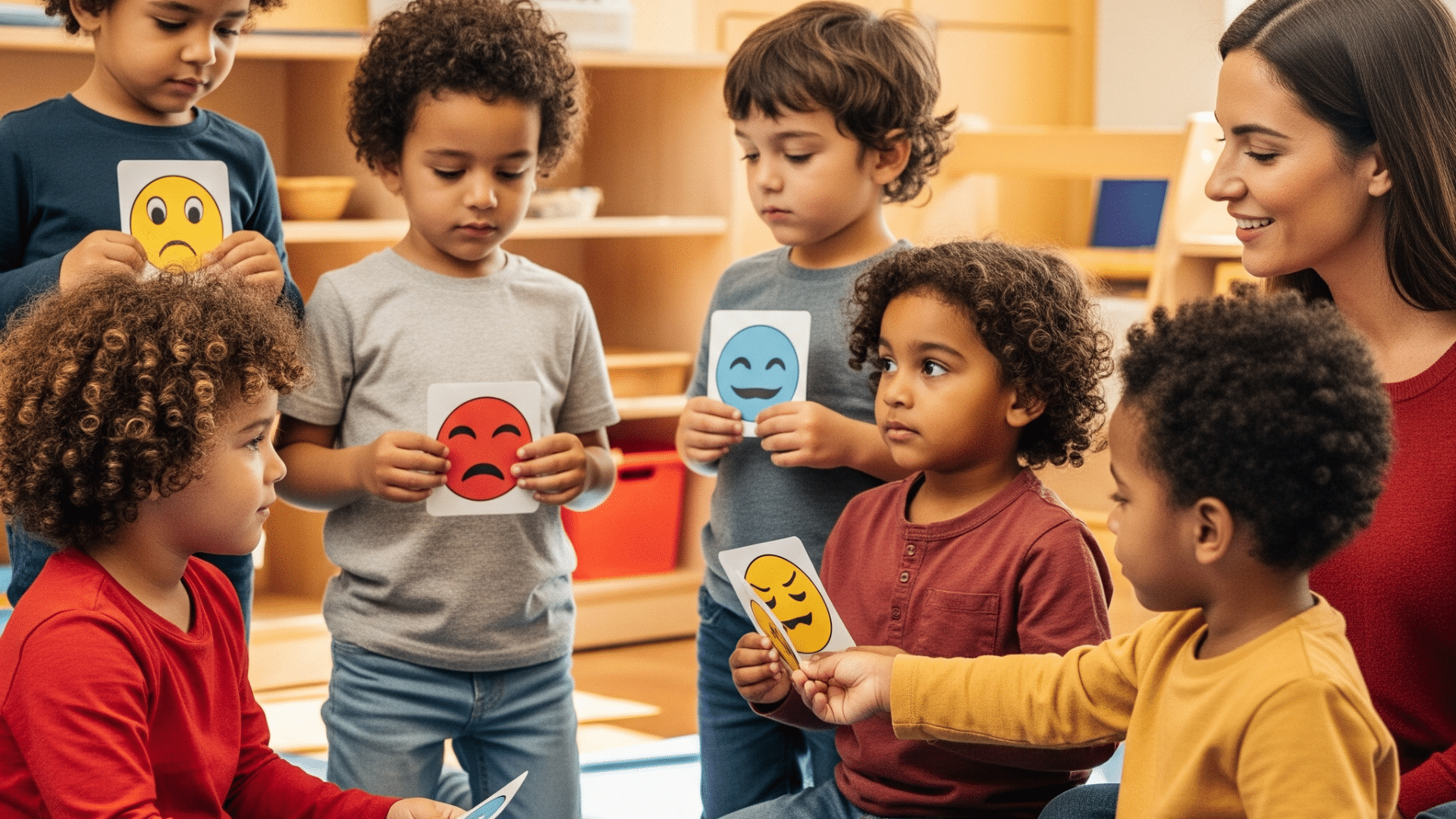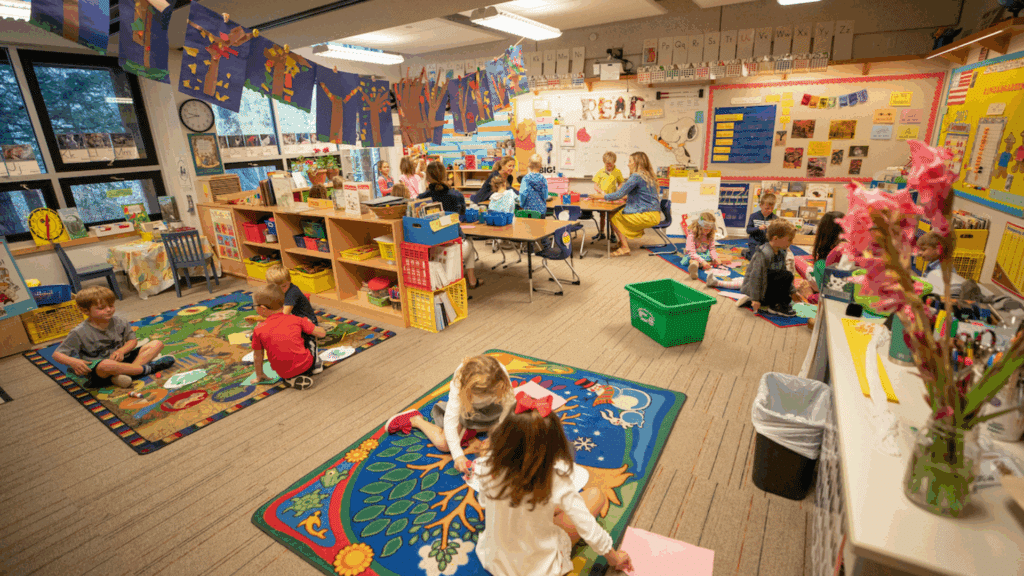Starting kindergarten is a significant milestone, and every child deserves a solid foundation to support their growth and thrive. A well-planned kindergarten scope and sequence can make all the difference in leading young learners through the acquisition of essential skills.
With the proper structure, teachers can help students build confidence while mastering key concepts in language, mathematics, and other subjects.
For parents and educators alike, understanding how to use this framework can bring clarity and ease to the early learning quest.
Let’s examine how a kindergarten scope and sequence lays the groundwork for success.
Table of Contents
- What is Scope and Sequence in Kindergarten?
- Key Components of a Kindergarten Scope and Sequence
- Thematic Units and the Month-by-Month Breakdown of a Kindergarten Year
- Sample Unit Calendar for Kindergarten
- Differentiating Instruction within the Scope and Sequence
- The Role of Parents and Caregivers in Supporting the Kindergarten Curriculum
- Bottom Line
What is Scope and Sequence in Kindergarten?
In kindergarten education, scope and sequence refer to the structure of what will be taught (scope) and the order in which it will be taught (sequence).
Scope
It includes key content areas such as language arts, math, science, and social-emotional development, outlining the essential skills and concepts for the year.
Sequence
It ensures these topics are introduced in a logical order, building upon foundational skills. This approach enables teachers to cover all necessary developmental milestones and support diverse learning needs.
Aligned with U.S. standards, such as the Common Core and Next Generation Science Standards, the scope and sequence ensure that kindergarten students meet national educational expectations, preparing them for future success.
Key Components of a Kindergarten Scope and Sequence

A well-rounded kindergarten curriculum in the U.S. covers a variety of essential learning areas. Here’s an overview of the key components:
1. English Language Arts (ELA)
- Phonics: Letter-sound relationships.
- Letter Recognition: Identifying and writing letters.
- Vocabulary: Expanding word knowledge through reading and conversation.
- Comprehension: Understanding stories, answering questions about the text.
- Early Writing: Drawing, labeling, and forming simple sentences.
2. Mathematics
- Number Sense: Recognizing numbers, counting, comparing quantities.
- Basic Operations: Simple addition and subtraction.
- Patterns: Identifying and creating repeating patterns.
- Shapes: Recognizing and naming basic geometric shapes.
- Measurement: Comparing length, weight, and volume.
- Data Collection: Sorting and organizing data.
3. Science
- Observations: Using the senses to explore the world.
- Exploration: Investigating objects, materials, and environments.
- Seasons: Understanding weather changes and seasonal patterns.
- Weather: Identifying types of weather.
- Basic Biology: Learning about plants, animals, and the five senses.
4. Social Studies
- Community: Roles of people in the community.
- Family Roles: Understanding family structures and responsibilities.
- Rules: Learning about classroom and societal rules.
- Basic Geography: Introduction to maps, locations, and directions.
- Citizenship: Learning about being a good citizen and respecting others.
5. Social-Emotional Learning (SEL)
- Emotional Awareness: Identifying and expressing emotions.
- Self-Regulation: Learning to control impulses and behaviors.
- Conflict Resolution: Solving problems with peers respectfully.
- Empathy: Understanding and sharing the feelings of others.
6. Physical Development
- Fine Motor Skills: Activities like cutting, drawing, and writing.
- Gross Motor Skills: Running, jumping, and physical play.
- Coordination: Developing hand-eye coordination.
- Health Education: Basic hygiene and understanding of body health.
7. Arts and Music
- Creative Expression: Using materials like paint and clay to create art.
- Rhythm: Clapping and tapping to music.
- Singing: Learning simple songs.
- Dancing: Exploring movement and rhythm through dance.
These key components work together to ensure that kindergarten students receive a balanced and comprehensive education, fostering cognitive, emotional, and physical development.
Thematic Units and the Month-by-Month Breakdown of a Kindergarten Year
Thematic units and month-by-month breakdowns help structure the kindergarten year, providing a clear roadmap for teachers and aligning with the scope and sequence of instruction.
Here are the steps for organizing the kindergarten curriculum by months and themes:
August-September: Introduction to the Classroom and Foundational Skills
Theme: “Welcome to Kindergarten!”
- Classroom Rules and Routines: Establishing expectations for behavior, classroom organization, and social-emotional learning.
- Introduction to Letters: Focus on letter recognition, beginning with A–F (and more if needed).
- Introduction to Numbers: Counting from 1 to 10, understanding the concept of numbers.
- Shapes and Colors: Recognizing and naming basic shapes (circle, square, triangle) and colors (red, blue, yellow).
Activities:
- Sing alphabet songs and practice writing letters.
- Use manipulatives for counting (blocks, counting bears).
- Play shape sorting games.
October–December: Building on Basic Skills and Exploring the World Around Us
Theme: “Exploring the World Around Us”
- Letter Recognition: Continue focusing on recognizing letters from A–Z. Introduce beginning sounds.
- Numbers 1–20: Counting, number writing, and simple number comparisons.
- Basic Shapes and Patterns: Review shapes and move on to identifying and creating patterns (AB, AAB, etc.).
- Seasons, Plants, and Animals: Begin exploring fall, the changing weather, and introduce plants and animals (e.g., the life cycle of a pumpkin or tree).
Activities:
- Create a classroom “alphabet wall” with pictures and letters.
- Practice counting objects and engaging in simple addition and subtraction with numbers 1–20.
- Go on a “nature walk” to observe seasonal changes and gather leaves, acorns, etc.
January–March: Expanding Knowledge and Understanding of the World
Theme: “Winter Wonders and Our Bodies”
- Sight Words: Introduce high-frequency sight words (e.g., “the,” “is”, “and”).
- Simple Addition and Subtraction: Introduce basic addition and subtraction with objects, stories, or visual aids (e.g., 2 + 3 = 5).
- Weather: Discuss winter weather patterns, basic climate types, and how weather affects us.
- The Human Body: Identify body parts and discuss health (e.g., hygiene, nutrition).
- Living vs. Non-Living Things: Introduce the concept of living and non-living things and their basic needs.
Activities:
- Sight word games and flashcards.
- Use objects like counters to visualize simple math problems.
- Science experiments on weather (e.g., making a cloud in a jar).
- Discuss healthy habits through stories or songs.
April–June: Review and Mastery
Theme: “End-of-Year Reflection and Exploration of the Universe”
- Sentence Building: Focus on creating simple sentences with sight words and phonics knowledge.
- Number Operations: Review addition and subtraction and explore more complex problems using visual aids and manipulatives.
- Earth and Space: Introduce the concepts of seasons, basic planetary knowledge, and how Earth changes over time.
- Review of Year’s Concepts: Reinforce key learning from earlier months, focusing on areas where students may need more practice.
Activities:
- Create “I Can” sentences on chart paper using sight words and phonics.
- Use number lines and manipulatives to practice addition and subtraction.
- Build a simple “model of the solar system” or create a “seasons” chart.
For a detailed timetable for the instructor, download the PDF.
Sample Unit Calendar for Kindergarten
By following a month-by-month thematic breakdown like this, teachers can maintain a structured but flexible approach that ensures all key learning areas are covered in a way that aligns with developmental stages.
This organization supports a balanced curriculum and allows for easy adjustments based on student needs and progress.
| Month | Theme | Key Focus Areas | Activities |
|---|---|---|---|
| August/September | Welcome to Kindergarten | Classroom rules, letters (A–F), numbers 1–10, shapes, colors | Create an alphabet wall, sorting shapes, and counting games |
| October–December | Exploring the World Around | Letters A–Z, numbers 1–20, shapes, patterns, seasons, plants, animals | Nature walks, pattern-making, and simple math activities |
| January–March | Winter Wonders and Our Bodies | Sight words, addition/subtraction, weather, body parts, living vs. non-living | Sight word games, weather experiments, body part songs |
| April–June | End-of-Year Reflection and Exploration of the Universe | Sentence building, number operations, Earth/Space, year review | Solar system model, number line practice, end-of-year project review |
Differentiating Instruction Within the Scope and Sequence
To provide teachers with strategies for adjusting the curriculum to meet the diverse needs of all learners, ensuring that every child can succeed.
These strategies will support differentiated instruction, allowing flexibility and inclusivity in the classroom.
Differentiation for Learning Styles
For visual learners, use charts, pictures, and written instructions; for auditory learners, incorporate songs, discussions, and read-alouds; and for kinesthetic learners, provide hands-on activities to engage them effectively.
Adjusting the Pace
For advanced students, provide enrichment activities such as problem-solving tasks or independent projects to deepen their learning.
For students with learning challenges, offer extra support through small group instruction, modified tasks, or one-on-one assistance to ensure they grasp the concepts effectively.
Integrating Play-Based Learning
Use play as a tool for learning key concepts, such as using blocks for counting or role-playing to practice social-emotional skills.
Culturally Responsive Teaching
Incorporate students’ diverse backgrounds by using materials and examples relevant to different cultures, ensuring inclusivity and respect for all students’ identities.
Tools and Resource Tips for Implementing a Kindergarten Scope and Sequence
Follow these tips for tools and resources, implementing a kindergarten scope and sequence:
1. Curriculum Maps and Pacing Guides: Use to outline the year’s content and keep track of which topics have been taught.
2. Teacher Planning Templates: Helps organize lesson plans, activities, and key learning objectives for each month or unit.
3. Online Resources for Lesson Plans: Websites like Teachers Pay Teachers, PBS Learning, and Scholastic offer ready-to-use activities and lesson plans.
4. Manipulatives and Visual Aids: Use counting blocks, flashcards, shape sorter toys, and visual charts to enhance learning, especially for kinesthetic and visual learners.
5. Technology Integration: Apps and websites, such as Khan Academy Kids or ABCmouse, can support interactive learning experiences.
6. Collaboration with Colleagues: Plan with co-teachers or specialists (special education, ESL) to ensure a comprehensive approach to differentiation.
7. Assessment Tools: Regular formative assessments (e.g., exit tickets, observation checklists) to track student progress and adjust instruction as needed.
The Role of Parents and Caregivers in Supporting the Kindergarten Curriculum
Parents and caregivers play a vital role in supporting the kindergarten curriculum.
Encouraging daily reading helps reinforce letter recognition, phonics, and early vocabulary. Engaging in simple math activities at home, like counting objects or sorting items, strengthens number sense.
Supporting social-emotional development through conversations about feelings and problem-solving builds essential life skills. Additionally, reinforcing classroom lessons through interactive games or hands-on activities enhances learning.
Clear communication with teachers, whether through parent-teacher meetings or digital platforms, ensures that families stay informed about their child’s progress, making them active partners in their child’s educational journey.
Bottom Line
A well-structured kindergarten scope and sequence sets the stage for future academic success. By covering key skills in a logical, paced way, it ensures no concept is missed and prepares students for the next steps in their learning.
Reflecting and adapting the curriculum to meet classroom needs keeps it compelling and engaging. This approach helps all children thrive, laying a strong foundation for the years ahead.
Feedback on how this structure works in your classroom is always appreciated!


















